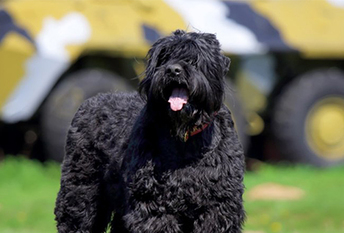The Otterhound is an average shedder who loses hair year round and must be brushed one to two times per week in order to avoid mats. Those individuals with soft coats must be brushed two to three times per week.
Clipping the coat is not a good idea. Once the dog's coat has been cut off, it can take up to two years to grow back in properly. Otterhounds are messy when it comes to eating and drinking, and his beard should be washed and dried daily to prevent tangles and unpleasant odors.
The ears should be checked on a regular basis for signs of wax buildup, irritation or infection. Clean them with a cotton ball and a veterinarian-approved cleanser; never use a cotton swab in a dog's ear canal.
Teeth should be brushed on a weekly basis to prevent tartar buildup, promote gum health and keep bad breath at bay. Trim nails monthly if the dog does not wear the toenails down naturally outdoors.
Otterhounds need mental as well as physical exercise. A large, securely fenced yard is a good beginning, but some hounds will lie under a tree in a fenced acre rather than self-exercise. Long walks to sniff the world and visit passersby are good for both owners and hounds.Obedience classes,tracking, andagilityall provide mental stimulation as well as good exercise.
Otterhounds are voracious eaters and should be fed on two meals of high-quality dry or canned food each day. Care should be taken to not over-feed these dogs. Due to their large barrel chests, they are also known to suffer from bloat and gastric torsion.
Any diet should be appropriate to the dog’s age (puppy, adult, or senior). Some dogs are prone to gettingoverweight, so watch your dog’s calorie consumption and weight level.
Treatscan be an important aid in training, but giving too many can cause obesity. Learn about whichhuman foodsare safe for dogs, and which are not.
Check with your vet if you have any concerns about your dog’s weight or diet.Clean, fresh water should be available at all times.
The average life span of the Otterhound is 10 to 13 years. Breed health concerns may includebloat (gastric dilatation and volvulus), elbow andhip dysplasia, multifocal retinal dysplasia, epilepsy, sebaceous cysts, panosteitis (shifting lameness),allergies,arthritisand Glanzmann’s thrombasthenia, a serious and potentially fatal bleeding disorder.
Otterhounds were never bred to be kept as companions and are therefore not the easiest of dogs to train. Training them requires a firm hand and a great deal of patience. They are also a good-natured breed and do not respond well to harsh training methods.
A firm but gentle approach always works best with this breed. It is also important that an Otterhound’s owner display consistent leadership as this dog can turn willful and stubborn if faced with a meek or passive owner.












